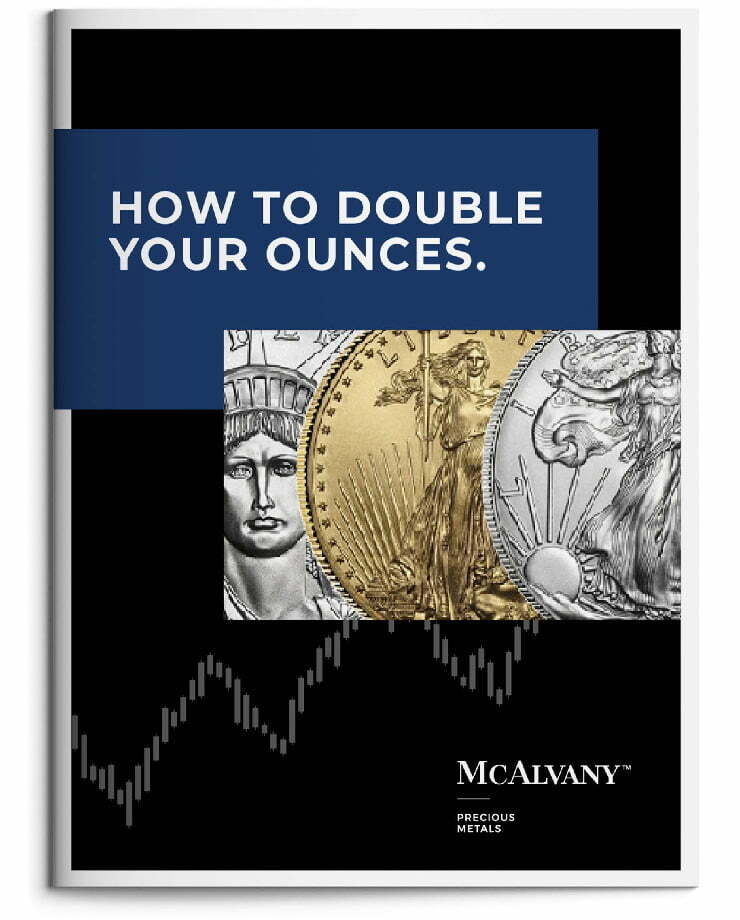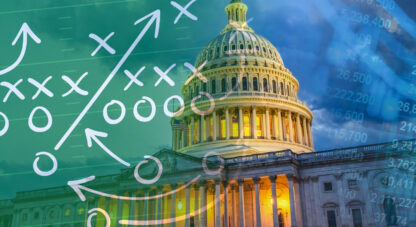A Barron’s article last December encouraged readers to “embrace the bubble” in stocks, and prepare for another banner S&P 500 year in 2025. This week, HAI would like to pour a little cold water on that bubble embrace and propose an alternative investment thesis. This alternative is ripe with potential upside that, far from a bubble, remains outside of Western investment consensus—for now.
Before embracing the bubble, consider the recent observation of HAI-favorite market commentator John Hussman, “The defining feature of a bubble is inconsistency between expected returns based on price behavior and expected returns based on valuations.” In other words, when they’re not in a bubble, markets are diligent in assessing value based on current and projected cash flows, then rationally extrapolating potential returns. By contrast, in a bubble, market participants’ expectations for returns gravitate away from calculated value and become driven by recent bullish price action and expectations for further future price momentum. In the mind of the bull, those expectations for endless upward price momentum—amid the bubble—are justified not by value, but by narrative alone.
Right now, as Hussman observed in his latest letter, “There’s no question that investors are eager to justify record valuation multiples by appealing to the growing share of technology companies in the S&P 500. Yet the technology sector itself is trading at the highest multiple to revenues on record. Meanwhile, the growth rate of overall S&P 500 revenues, which include the technology sector, is below historical norms while the S&P 500 price/revenue multiple is three times its historical norm, easily eclipsing the 1929 and 2000 peaks… For the moment, neither valuations nor arithmetic matter to investors.”
Now, while rational markets have proven one of the greatest wealth-generating constructs in human history, bursting bubbles are incredibly destructive and financially ruinous events. And history is unambiguous—bubbles always burst.
The exact trigger that catalyzes the cascading bust can, in theory, be anything. But the reality is that the record valuations themselves leave the market vulnerable to a hundred risks, not just one. As Hussman warns, “Presently, our most reliable valuation measures exceed those observed at the 1929 and 2000 peaks, and I continue to view the period since early 2022 as the extended peak of the third great speculative bubble in U.S. history—implying the most negative prospects for expected S&P 500 total returns on record.”
To be clear, in HAI’s view, we have a mighty big old bubble on our hands. Bullish price action and expectations for further future price momentum have firmly taken hold. Currently, speculators are basing their untethered expectations on rampant enthusiasm over the narratives of artificial intelligence, the prospects for deregulation, and the assumption of lower corporate and income taxes. Fair enough, but it’s worth remembering that recent decades have also delivered some rather remarkable society-changing innovations, deregulation, and tax cuts. In spite of them, both GDP and S&P 500 Index revenues (including the impact of stock buybacks) have grown slower, not faster, than the preceding half-century.
Facing what is perhaps history’s greatest bubble and the looming threat of its implosion, we might do well to recall the wisdom of economist John Kenneth Galbraith. In his 1990 classic, A Short History of Financial Euphoria, Galbraith observed, “There can be few fields of human endeavor in which history counts for so little as in the world of finance. Past experience, to the extent that it is part of memory at all, is dismissed as the primitive refuge of those who do not have the insight to appreciate the incredible wonders of the present. Only after the speculative collapse does the truth emerge.”
In short, to play the momentum of a late-stage speculative bubble is to play with fire, but HAI isn’t interested in burning down portfolios. Fortunately, some distance from the perilous powder keg, we have the opportunity to invest in the monetary metals and their related producers on the cusp of what increasingly looks like what Leigh Goehring in last week’s HAI called “a major monetary regime change”—a regime change that’s very likely to result in a much higher gold price. As HAI has explained in recent weeks, this monetary regime change is the inevitable result of the now unacceptably high cost suffered by the U.S. as reserve currency issuer from late-stage Triffin’s Dilemma-like dynamics.
Again, with a massive debt and deficit problem, an inflation problem, a domestic manufacturing problem (which doubles as a serious national security problem), and a trapped Fed now unable to effectively use interest rate policy, the U.S. is suffering the flaws of the post-1971 dollar-based global monetary system. It seems we’ve hit the breaking point of that old system, and now it appears the Trump administration is intent on initiating a monetary regime change—and initiating it soon.
This week, the latest quarterly Treasury report (TBAC) confirms that the U.S. fiscal position continues to deteriorate at an alarming pace. According to the Treasury, U.S. “true interest expense” (entitlements + gross interest expense) is up to 109% of tax receipts, and that number jumps to 117% of receipts when including the now $400 billion annualized spending on Veteran’s Affairs.
For context, U.S. tax receipts last year amounted to $4.92 trillion in federal revenue. Even though U.S. tax receipts are down year-over-year so far this fiscal year (starting in October), if we assume the same 2024 tax income for the government this year, at the current rate of annualized spending the U.S. could entirely cut all other federal outlays (including all defense spending) and we would still run a $320 billion deficit. Furthermore, that true interest expense is growing at a far faster rate than nominal GDP. That means we’re not growing our way out of this debt trap, we’re spending our way ever deeper into it. The point is, the U.S. has an increasingly acute fiscal problem, and, while DOGE can trim some minor fat, it is by no means even close to an answer to the growing fiscal problem.
If we add up true interest expense plus veteran’s affairs plus defense spending (none of which DOGE will be able to cut) that bill is now 137% of U.S. tax receipts. Importantly, the only “easily” cut portion of that spending is interest expense. But to do that, the Fed would have to aggressively cut interest rates despite inflation that remains well above target and has been rising again for months. The Fed would also have to do that aggressive rate cutting despite the fact that the University of Michigan’s latest consumer survey showed that Americans’ inflation expectations for the year ahead surged this month to 4.3%, up a full percentage point since just January.
The U.S. is rapidly running out of road down which it can kick the can on a whole host of critical problems. As a result, the Trump administration must now think outside the box for big answers to big problems. In HAI’s view, that is exactly what this administration is doing.
However, any policy maneuvering that sends the dollar and Treasury yields meaningfully higher risks popping the stock market bubble. That would cascade into a sharp decline in the U.S. economy and, by extension, U.S. tax receipts. A yields-up (higher interest expense) and tax receipts-down (less government revenue) dynamic would trigger an accelerated U.S. debt spiral. That would likely discredit and undermine the Trump administration’s economic policy plans before they could have any chance of righting the ship. As a result, HAI expects that the Trump administration won’t be shy about pulling radical policy levers—levers that are likely to soon weaken the dollar and attempt to keep a lid on yields. Such policies would also help fulfill a campaign promise—and national security imperative—to revitalize U.S. manufacturing through a weaker, more competitive dollar.
If that’s correct, it means that investors need to consider that the seemingly impossible may indeed now be possible. The U.S. may be ready to orchestrate what Scott Bessent described last summer as a Bretton Woods-like “grand global economic reordering.” The U.S. might be ready to implement radical policies that amount to a global monetary shift from the old post-1971 “dollar recycling” petrodollar system to a new “gold recycling” system. And as Stephen Miran, Trump’s new head of the Council of Economic Advisors wrote in November, “these policies may supercharge efforts of those looking to minimize exposure to the United States. Efforts to find alternatives to the dollar and dollar assets will intensify…but alternative reserve assets like gold…will likely benefit.”
Make no mistake, at present investors still face a veritable sea of unknowns. But in simplified terms, the balance of evidence now points strongly toward weak-dollar inflationary policies at the least, and at the most a full-court press towards a comprehensive weaker-dollar monetary regime change that aims to replace Treasuries with gold as global reserve asset. Either way, gold wins big, and its price continues the race to the upside.
We currently have a stock market bubble that faces a hundred threats, with a concurrent set-up in precious metals that forcefully points toward gold’s shining moment. Given what we know amid this sea of unknowns, rather than “embrace the bubble,” HAI is comfortably embracing gold and its related producers amid what increasingly looks like a generational opportunity in the yellow metal.
Weekly performance: The S&P 500 was down 0.24%. Gold was up 1.86%, silver was higher by 0.55%, platinum was off 2.19%, and palladium was down 8.34%. The HUI gold miners index was up 4.67%. The IFRA iShares US Infrastructure ETF was down 0.23%. Energy commodities were volatile and down on the week. WTI crude oil was off 2.11%, while natural gas was up 7.34%. The CRB Commodity Index was up 0.82%. Copper surged by 7.24%. The Dow Jones US Specialty Real Estate Investment Trust Index was up 1.84%. The Vanguard Utilities ETF was up 0.36%. The dollar index was down 0.27% to close the week at 107.93. The yield on the 10-yr U.S. Treasury was down by 5 bps to close at 4.50%.
Have a wonderful weekend!
Best Regards,
Morgan Lewis
Investment Strategist & Co-Portfolio Manager
MWM LLC















